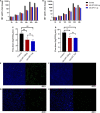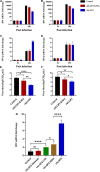Chicken-Derived Pattern Recognition Receptor chLGP2 Inhibits the Replication and Proliferation of Infectious Bronchitis Virus
- PMID: 35145497
- PMCID: PMC8824401
- DOI: 10.3389/fmicb.2021.810215
Chicken-Derived Pattern Recognition Receptor chLGP2 Inhibits the Replication and Proliferation of Infectious Bronchitis Virus
Abstract
The widespread nature and economic importance of Infectious bronchitis virus (IBV) and interactions between IBV and the host immune response remain poorly understood. Understanding the mechanism of virus recognition via innate immunity can help resist IBV invasion. Retinoic acid-induced gene I-like receptor (RLRs) recognize virus RNA in virus infection, and LGP2 is a member of RLRs. According to the current studies, LGP2 exhibited certain inhibition in the virus, and there is a lack of investigation for chicken's LGP2. It is important to figure out the role of chLGP2 in host immune recognition of IBV. Our results showed that chLGP2 inhibited the proliferation of IBV Beaudette in cells. Also, chLGP2 can identify and combine with IBV RNA. The domains of chLGP2 were separately expressed and inspired by related literature, and the chLGP2 K30A mutant was constructed. Our results suggested its structural integrity and the adenosine triphosphatase (ATPase) activity are critical for IBV inhibiting activity. chTRBP was selected after CO-IP and Mass spectrometry test. We found chTRBP and chLGP2 are the interacting partners and promote mutual expression. Our study showed that chTRBP could also suppress IBV infections via chLGP2, which provided a basis for future innate immunity research for IBV.
Keywords: IBV; IFN-β; chLGP2; chTRBP; innate immunity.
Copyright © 2022 Wang, Cui, Ni, Gong, Li, Yan, Fu, Chen, Lei, Wang and Yang.
Conflict of interest statement
The authors declare that the research was conducted in the absence of any commercial or financial relationships that could be construed as a potential conflict of interest.
Figures






Similar articles
-
Infectious bronchitis virus nucleocapsid protein suppressed type I interferon production by interfering with the binding of MDA5-dsRNA and interacting with LGP2.Vet Microbiol. 2023 Sep;284:109798. doi: 10.1016/j.vetmic.2023.109798. Epub 2023 Jun 8. Vet Microbiol. 2023. PMID: 37307767
-
Effect of TLR agonist on infections bronchitis virus replication and cytokine expression in embryonated chicken eggs.Mol Immunol. 2020 Apr;120:52-60. doi: 10.1016/j.molimm.2020.02.001. Epub 2020 Feb 14. Mol Immunol. 2020. PMID: 32065987 Free PMC article.
-
Induction of innate host responses characterized by production of interleukin (IL)-1β and recruitment of macrophages to the respiratory tract of chickens following infection with infectious bronchitis virus (IBV).Vet Microbiol. 2018 Feb;215:1-10. doi: 10.1016/j.vetmic.2018.01.001. Epub 2018 Jan 3. Vet Microbiol. 2018. PMID: 29426399
-
Current Knowledge on Infectious Bronchitis Virus Non-structural Proteins: The Bearer for Achieving Immune Evasion Function.Front Vet Sci. 2022 Apr 8;9:820625. doi: 10.3389/fvets.2022.820625. eCollection 2022. Front Vet Sci. 2022. PMID: 35464391 Free PMC article. Review.
-
Infectious Bronchitis Coronavirus Infection in Chickens: Multiple System Disease with Immune Suppression.Pathogens. 2020 Sep 24;9(10):779. doi: 10.3390/pathogens9100779. Pathogens. 2020. PMID: 32987684 Free PMC article. Review.
Cited by
-
Pathologic Mechanisms of the Newcastle Disease Virus.Viruses. 2023 Mar 28;15(4):864. doi: 10.3390/v15040864. Viruses. 2023. PMID: 37112843 Free PMC article. Review.
-
Chicken intestinal microbiota modulation of resistance to nephropathogenic infectious bronchitis virus infection through IFN-I.Microbiome. 2022 Oct 3;10(1):162. doi: 10.1186/s40168-022-01348-2. Microbiome. 2022. PMID: 36192807 Free PMC article.
-
Roles of RNA Sensors in Host Innate Response to Influenza Virus and Coronavirus Infections.Int J Mol Sci. 2022 Jul 27;23(15):8285. doi: 10.3390/ijms23158285. Int J Mol Sci. 2022. PMID: 35955436 Free PMC article. Review.
-
Isolation of a more aggressive GVI-1 genotype strain HX of the avian infectious bronchitis virus.Poult Sci. 2024 Dec;103(12):104285. doi: 10.1016/j.psj.2024.104285. Epub 2024 Sep 1. Poult Sci. 2024. PMID: 39326178 Free PMC article.
References
LinkOut - more resources
Full Text Sources

